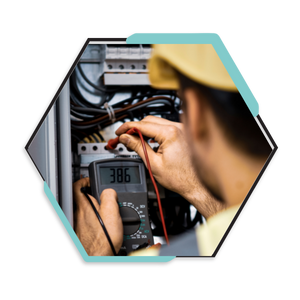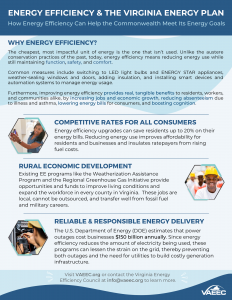An Introduction to Energy Efficiency
What is energy efficiency, exactly? The cheapest, most impactful unit of energy is the one that isn’t used. Unlike the austere conservation practices of the past, today, energy efficiency means reducing energy use while still maintaining function, safety, and comfort.
Common measures include switching to LED light bulbs and ENERGY STAR appliances, weather-sealing windows and doors, adding insulation to walls, ceilings, and roofs, and installing smart devices and automation systems to control and monitor energy usage.
According to the U.S. Department of Energy, improving energy efficiency is “one of the easiest and most cost-effective ways to combat climate change, clean the air we breathe, improve the competitiveness of our businesses and reduce energy costs for consumers”.
Furthermore, improving energy efficiency provides real, tangible benefits to residents, workers, and communities alike, by increasing jobs and economic growth, reducing absenteeism due to illness and asthma, lowering energy bills for consumers, and boosting comfort and cognition.
 Jobs: There are over 73K energy efficiency jobs in VA (US Department of Energy). These jobs are local, cannot be outsourced, and benefit the economy and livelihood of the communities where they work. Also, as businesses navigate plans to return to the office, energy efficiency measures can improve cognition (Harvard School of Public Health), reduce absenteeism, and make a space more comfortable for workers.
Jobs: There are over 73K energy efficiency jobs in VA (US Department of Energy). These jobs are local, cannot be outsourced, and benefit the economy and livelihood of the communities where they work. Also, as businesses navigate plans to return to the office, energy efficiency measures can improve cognition (Harvard School of Public Health), reduce absenteeism, and make a space more comfortable for workers.
Health: Many of the most common infectious diseases, such as COVID-19, the flu, and the common cold, are airborne. Better indoor air quality lowers the rate of infection, as well as reduces the risk of asthma, COPD, and cardiac illness.
 Affordability: Energy efficiency improvements can save low-income customers up to $100/month on energy bills. While energy-efficient equipment and solutions may have a higher upfront cost, the cumulative savings over time add up to hundreds and sometimes thousands of dollars. Financing mechanisms are available to help reduce upfront costs for consumers.
Affordability: Energy efficiency improvements can save low-income customers up to $100/month on energy bills. While energy-efficient equipment and solutions may have a higher upfront cost, the cumulative savings over time add up to hundreds and sometimes thousands of dollars. Financing mechanisms are available to help reduce upfront costs for consumers.
Comfort: Air sealing measures, such as better insulation and windows, reduce drafts and temperature fluctuations and block outside noises, contributing to a more peaceful living or working environment.
 Resiliency & Environment: Stricter building codes and green building standards help structures withstand extreme heat, cold, and moisture. Energy-efficient building methods and materials also help cope with the effects of natural disasters. Additionally, energy efficiency eases the transition towards renewable energy by reducing demand on our grid and resources. Through building automation systems and smart technologies, building inhabitants can lower energy consumption at scale and decrease reliance on foreign fuel sources.
Resiliency & Environment: Stricter building codes and green building standards help structures withstand extreme heat, cold, and moisture. Energy-efficient building methods and materials also help cope with the effects of natural disasters. Additionally, energy efficiency eases the transition towards renewable energy by reducing demand on our grid and resources. Through building automation systems and smart technologies, building inhabitants can lower energy consumption at scale and decrease reliance on foreign fuel sources.
“Energy efficiency is a critical solution to so many of the world’s most urgent challenges; it can simultaneously make our energy supplies more affordable, more secure, and more sustainable,” says IEA Executive Director Fatih Birol.
Resources
- Check out our 2025 EE 101 fact sheet.
- Confused by all of the acronyms floating around? Check out our cheatsheet, Common Energy Efficiency Acroymns.
- To learn how energy efficiency can help the Commonwealth reach its energy goals, check out our latest factsheet, Energy Efficiency & The Virginia Energy Plan: How EE Can Help the Commonwealth Meet its Energy Goals.
- For more information, check out our report, Why Energy Efficiency is a Smart Investment for Virginia: Making the business case for energy efficiency. Data in the report show that energy efficiency is a $1.5B industry in Virginia that supports 73,000 jobs. The report includes a set of policy recommendations paired with case studies to underscore the potential for those policies and programs to drive even more economic and clean energy growth in the Commonwealth.

